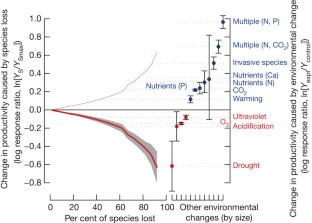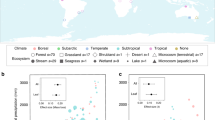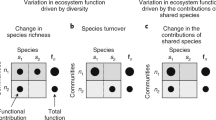Abstract
Evidence is mounting that extinctions are altering key processes important to the productivity and sustainability of Earth’s ecosystems1,2,3,4. Further species loss will accelerate change in ecosystem processes5,6,7,8, but it is unclear how these effects compare to the direct effects of other forms of environmental change that are both driving diversity loss and altering ecosystem function. Here we use a suite of meta-analyses of published data to show that the effects of species loss on productivity and decomposition—two processes important in all ecosystems—are of comparable magnitude to the effects of many other global environmental changes. In experiments, intermediate levels of species loss (21–40%) reduced plant production by 5–10%, comparable to previously documented effects of ultraviolet radiation and climate warming. Higher levels of extinction (41–60%) had effects rivalling those of ozone, acidification, elevated CO2 and nutrient pollution. At intermediate levels, species loss generally had equal or greater effects on decomposition than did elevated CO2 and nitrogen addition. The identity of species lost also had a large effect on changes in productivity and decomposition, generating a wide range of plausible outcomes for extinction. Despite the need for more studies on interactive effects of diversity loss and environmental changes, our analyses clearly show that the ecosystem consequences of local species loss are as quantitatively significant as the direct effects of several global change stressors that have mobilized major international concern and remediation efforts9.
This is a preview of subscription content, access via your institution
Access options
Subscribe to this journal
Receive 51 print issues and online access
$199.00 per year
only $3.90 per issue
Buy this article
- Purchase on Springer Link
- Instant access to full article PDF
Prices may be subject to local taxes which are calculated during checkout


Similar content being viewed by others

References
Loreau, M., Naeem, S. & Inchausti, P. Biodiversity and Ecosystem Functioning: Synthesis and perspectives (Oxford Univ. Press, 2002)
Hooper, D. U. et al. Effects of biodiversity on ecosystem functioning: a consensus of current knowledge. Ecol. Monogr. 75, 3–35 (2005)
Tilman, D. Ecological consequences of biodiversity: a search for general principles. Ecology 80, 1455–1474 (1999)
Wardle, D. A., Bardgett, R. D., Callaway, R. M. & Van der Putten, W. H. Terrestrial ecosystem responses to species gains and losses. Science 332, 1273–1277 (2011)
Balvanera, P. et al. Quantifying the evidence for biodiversity effects on ecosystem functioning and services. Ecol. Lett. 9, 1146–1156 (2006)
Cardinale, B. J. et al. The functional role of producer diversity in ecosystems. Am. J. Bot. 98, 572–592 (2011)
Stachowicz, J. J., Bruno, J. F. & Duffy, J. E. Understanding the effects of marine biodiversity on communities and ecosystems. Annu. Rev. Ecol. Evol. Syst. 38, 739–766 (2007)
Perrings, C. et al. Ecosystem services, targets, and indicators for the conservation and sustainable use of biodiversity. Front. Ecol. Environ 9, 512–520 (2011)
IPCC . Climate Change 2007: Synthesis Report. Contribution of Working Groups I, II and III to the Fourth Assessment Report of the Intergovernmental Panel on Climate Change (eds Core Writing Team, Pachauri, R. K. & Reisinger, A. ) (IPCC, 2007)
Sala, O. E. et al. Global biodiversity scenarios for the year 2100. Science 287, 1770–1774 (2000)
Millennium Ecosystem Assessment. Ecosystems and Human Well-being: Biodiversity Synthesis (World Resources Institute, 2005)
Barnosky, A. D. et al. Has the Earth’s sixth mass extinction already arrived? Nature 471, 51–57 (2011)
Chapin, F. S., III et al. Consequences of changing biodiversity. Nature 405, 234–242 (2000)
Grace, J. B. et al. Does species diversity limit productivity in natural grassland communities? Ecol. Lett. 10, 680–689 (2007)
Paquette, A. & Messier, C. The effect of biodiversity on tree productivity: from temperate to boreal forests. Glob. Ecol. Biogeogr. 20, 170–180 (2011)
Srivastava, D. S. & Vellend, M. Biodiversity-ecosystem function research: is it relevant to conservation? Annu. Rev. Ecol. Evol. Syst. 36, 267–294 (2005)
Rockström, J. et al. A safe operating space for humanity. Nature 461, 472–475 (2009)
Díaz, S., Wardle, D. A. & Hector, A. in Biodiversity, Ecosystem Functioning, and Human Wellbeing: An Ecological and Economic Perspective (eds Naeem, S. et al.) Ch. 11 149–166 (Oxford Univ. Press, 2009)
Pereira, H. M. et al. Scenarios for global biodiversity in the 21st century. Science 330, 1496–1501 (2010)
Brook, B. W., Sodhi, N. S. & Bradshaw, C. J. A. Synergies among extinction drivers under global change. Trends Ecol. Evol. 23, 453–460 (2008)
Ewers, R. M. & Didham, R. K. Confounding factors in the detection of species responses to habitat fragmentation. Biol. Rev. Camb. Philos. Soc. 81, 117–142 (2006)
Wang, X. Effects of species richness and elevated carbon dioxide on biomass accumulation: a synthesis using meta-analysis. Oecologia 152, 595–605 (2007)
Elser, J. J. et al. Global analysis of nitrogen and phosphorus limitation of primary producers in freshwater, marine and terrestrial ecosystems. Ecol. Lett. 10, 1135–1142 (2007)
Vitousek, P. M. et al. Human alteration of the global nitrogen cycle: sources and consequences. Ecol. Appl. 7, 737–750 (1997)
Carpenter, S. R. et al. Nonpoint pollution of surface waters with phosphorus and nitrogen. Ecol. Appl. 8, 559–568 (1998)
Tylianakis, J. M., Didham, R. K., Bascompte, J. & Wardle, D. A. Global change and species interactions in terrestrial ecosystems. Ecol. Lett. 11, 1351–1363 (2008)
Suding, K. N. et al. Scaling environmental change through the community-level: a trait-based response-and-effect framework for plants. Glob. Change Biol. 14, 1125–1140 (2008)
Larigauderie, A. & Mooney, H. A. The Intergovernmental science-policy Platform on Biodiversity and Ecosystem Services: moving a step closer to an IPCC-like mechanism for biodiversity. Curr. Opin. Environ. Sust. 2, 9–14 (2010)
Schmid, B., Hector, A., Saha, P. & Loreau, M. Biodiversity effects and transgressive overyielding. J. Plant Ecol. 1, 95–102 (2008)
Johnson, N. J. Modified t tests and confidence intervals for asymmetrical populations. J. Am. Stat. Assoc. 73, 536–544 (1978)
Rixen, C., Huovinen, C., Huovinen, K., Stöckli, V. & Schmid, B. A plant diversity×water chemistry experiment in subalpine grassland. Perspect. Plant Ecol. 10, 51–61 (2008)
Reich, P. B. et al. Plant diversity enhances ecosystem responses to elevated CO2 and nitrogen deposition. Nature 410, 809–810 (2001)
Maestre, F. T. & Reynolds, J. F. Biomass responses to elevated CO2, soil heterogeneity and diversity: an experimental assessment with grassland assemblages. Oecologia 151, 512–520 (2007)
Stocker, R., Körner, C., Schmid, B., Niklaus, P. A. & Leadley, P. W. A field study of the effects of elevated CO2 and plant species diversity on ecosystem-level gas exchange in a planted calcareous grassland. Glob. Change Biol. 5, 95–105 (1999)
Mulder, C. P. H., Uliassi, D. D. & Doak, D. F. Physical stress and diversity-productivity relationships: the role of positive species interactions. Proc. Natl Acad. Sci. USA 98, 6704–6708 (2001)
Rixen, C. & Mulder, C. P. H. Improved water retention links high species richness with increased productivity in arctic tundra moss communities. Oecologia 146, 287–299 (2005)
Wenninger, E. J. & Inouye, R. S. Insect community response to plant diversity and productivity in a sagebrush–steppe ecosystem. J. Arid Environ. 72, 24–33 (2008)
Wacker, L., Baudois, O., Eichenberger-Glinz, S. & Schmid, B. Diversity effects in early- and mid-successional species pools along a nitrogen gradient. Ecology 90, 637–648 (2009)
Striebel, M., Behl, S. & Stibor, H. The coupling of biodiversity and productivity in phytoplankton communities: consequences for biomass stoichiometry. Ecology 90, 2025–2031 (2009)
Fridley, J. D. Resource availability dominates and alters the relationship between species diversity and ecosystem productivity in experimental plant communities. Oecologia 132, 271–277 (2002)
Lanta, V. & Leps, J. Effect of functional group richness and species richness in manipulated productivity–diversity studies: a glasshouse pot experiment. Acta Oecol. 29, 85–96 (2006)
Smith, A. & Allcock, P. J. The influence of species diversity on sward yield and quality. J. Appl. Ecol. 22, 185–198 (1985)
Boyer, K. E., Kertesz, J. S. & Bruno, J. F. Biodiversity effects on productivity and stability of marine macroalgal communities: the role of environmental context. Oikos 118, 1062–1072 (2009)
von Felten, S. & Schmid, B. Complementarity among species in horizontal versus vertical rooting space. J. Plant Ecol. 1, 33–41 (2008)
De Boeck, H. J. et al. Biomass production in experimental grasslands of different species richness during three years of climate warming. Biogeosciences 5, 585–594 (2008)
Fridley, J. D. Diversity effects on production in different light and fertility environments: an experiment with communities of annual plants. J. Ecol. 91, 396–406 (2003)
Acknowledgements
We thank the authors of the original data sets, both published and unpublished, who shared data with us. We thank the National Center for Ecological Analysis and Synthesis (NCEAS) for funding the workshop “Biodiversity and the Functioning of Ecosystems: Translating Results from Model Experiments into Functional Reality”. Support for NCEAS comes from University of California Santa Barbara and the National Science Foundation. J.E.K.B., E.C.A. and M.I.O. had NCEAS post-doctoral fellowships, J.E.D. had support from NSF OCE-1031061; B.J.C. had support from NSF DEB-1046121; L.G. was supported by grant 621-2009-5457 from the Swedish Research Council VR; A.G. is supported by the Canada Research Chair Program and NSERC.
Author information
Authors and Affiliations
Contributions
All authors contributed to the design of the study, data interpretation and manuscript editing; B.J.C. and K.L.M. developed the database of biodiversity and ecosystem functioning experiments; D.U.H., E.C.A., J.E.K.B., B.J.C. and K.L.M. collected additional data and performed statistical analyses. E.C.A., J.E.K.B., B.J.C., B.A.H. and D.U.H. drafted the figures and D.U.H. wrote the initial draft.
Corresponding author
Ethics declarations
Competing interests
The authors declare no competing financial interests.
Additional information
The biodiversity and ecosystemfunctioning database is deposited with the National Center for Ecological Analysis and Synthesis (http://knb.ecoinformatics.org/knb/metacat/nceas.984/nceas).
Supplementary information
Supplementary Information
This file contains Supplementary Tables 1-3, Supplementary Figures 1-6, Supplementary Discussions on Productivity and Decomposition and additional references. (PDF 1165 kb)
PowerPoint slides
Rights and permissions
About this article
Cite this article
Hooper, D., Adair, E., Cardinale, B. et al. A global synthesis reveals biodiversity loss as a major driver of ecosystem change. Nature 486, 105–108 (2012). https://doi.org/10.1038/nature11118
Received:
Accepted:
Published:
Issue Date:
DOI: https://doi.org/10.1038/nature11118
This article is cited by
-
Cumulative effects of offshore wind farms on common guillemots (Uria aalge) in the southern North Sea - climate versus biodiversity?
Biodiversity and Conservation (2024)
-
A review of the life history and ecology of euryhaline and estuarine sharks and rays
Reviews in Fish Biology and Fisheries (2024)
-
Competition for nitrogen between plants and microorganisms in grasslands: effect of nitrogen application rate and plant acquisition strategy
Biology and Fertility of Soils (2024)
-
Linkages between plant functional diversity and soil-based ecosystem services in urban and peri-urban vacant lots
Urban Ecosystems (2024)
-
Climate change filtered out resource-acquisitive plants in a temperate grassland in Inner Mongolia, China
Science China Life Sciences (2024)
Comments
By submitting a comment you agree to abide by our Terms and Community Guidelines. If you find something abusive or that does not comply with our terms or guidelines please flag it as inappropriate.


